Next to mosquitoes, ticks are considered one of the primary concerns for public health. After more than one personal interaction with a tick over the last few weeks, it felt like an opportune time to discuss various tick species and their impact on human health and well being.
To start, ticks are not insects. Exhibiting eight legs and lacking a segmented abdomen, they are in fact arachnids and as such are closely related to spiders and mites. Belonging to the order Ixodida, there are three families of ticks, two of which can be found here in Florida. The first is the family Ixodidae, also commonly referred to as hard ticks. The second family is Argasidae, or the soft ticks. While soft ticks are parasitic on several vertebrate organisms, hard ticks (Ixodidae) are the primary cause for concern with regard to public health.
There are five species of hard ticks here in Florida that you are most likely to come in contact with: the black legged tick (Ixodes scapularis), the american dog tick (Dermacentor variabilis), the lone star tick (Amblyomma americanum),the gulf coast tick (Amblyomma maculatum), and the brown dog tick (Rhipicephalus sanguineus). From a disease transmission perspective, all five of these species are of particular concern because they are obligate parasites, required to consume a blood meal from three separate animal hosts.
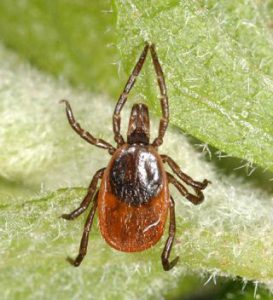
1. Black legged tick (Ixodes scapularis): Also referred to as the deer tick, this species is also commonly found in the northeastern United States. Smaller in size, it consumes its blood meal in its nymphal stage from smaller to medium sized mammals, as well as birds and reptiles. Adult females are red and black in color, while the males are darker brown. Adults will primarily feed on deer, dogs, and humans. They are typically active from September to May and can be found throughout heavily wooded areas as well as edges of forest patches.
Diseases: Lyme disease (Borrelia burgdorferi), Babesiosis, and HGA (human granulocytic anaplasmosis).
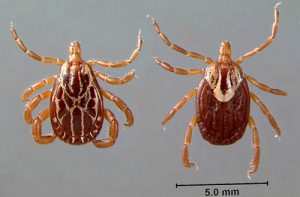
2. Gulf coast tick (Amblyomma maculatum): The adult stage is the most commonly observed for this tick species. Adults are light brown with a white ornamentation. Nymphs can be found in early spring (January-March), and adults March through September. They commonly feed on large mammals such as cattle, causing physical abnormalities along with general lethargy and debilitation.
Diseases: Mild spotted fever disease (Rickettsia parkeri).
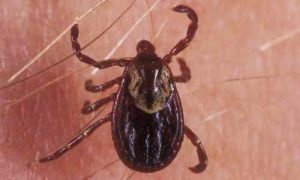
3. American dog tick (Dermacentor variabilis): The immature stages of this tick species can be found on smaller rodents, while the adults are primarily found feeding dogs and humans. Abundant from March-September, they are found in open, disturbed habitats like grassy fields, as well as along the edges of wooded areas. Unlike the brown dog tick, they generally reside outdoors and you are more likely to be bitten by the adult females. These adults are brown with white markings and are fairly large as compared to other tick species.
Diseases: Rocky mountain spotted fever (Rickettsia rickettsi) and tularemia (Francisella tularensis). The toxic secretion from the American dog tick can also cause paralysis in dogs and children if attached to the base of the skull or spinal column.
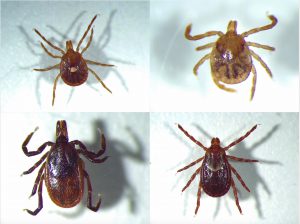
4. Lone star tick (Amblyomma americanum): All life stages of this tick species will attach and feed on humans and other domestic animals, and it is perhaps the most common human-biting tick in Florida. Adult females are golden brown in color with a distinctive white spot on their back. Nymphs occur from February-October, while adults can be found April-August, with particularly high population densities in July. They can be found in a wide range of habitats including heavily wooded and open areas.
Diseases: Ehrlichia chaffeensis and E. ewingii (which cause human ehrlichiosis), tularemia (Francisella tularensis), Heartland virus (Heartland virus disease), Bourbon virus (Bourbon virus disease), and Southern tick-associated rash illness (STARI). Allergic reactions to red meat have also been associated with bites from the lone star tick.
5. Rhipicephalus sanguineus – the brown dog tick. This tick can be found throughout much of the world. Although it can occasionally be found on wildlife or feeding on humans, it is primarily found on domestic dogs. In fact, while not feeding, these hard ticks will readily establish themselves in the cracks of walls within a home or kennels, continuing to reproduce and increase their population densities.
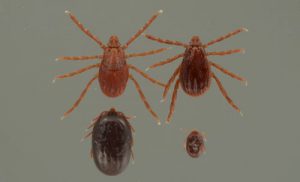
Diseases: Ehrlichia, Rocky mountain spotted fever.
Reducing the likelihood of having a tick initially attach, prior to feeding, is key. Wearing long pants that are properly tucked into boots and/or socks and using a chemical repellent can be helpful. Be sure to inspect yourself and others for ticks after hiking in wooded or open grassy areas. Generally, ticks will not begin transmitting pathogens (if present) until they have been attached for a period of 24-48 hours. So again, performing proper tick checks after outdoor activities is critical.
It is extremely important to not attempt to burn off a tick for removal, or grab the abdomen of an attached tick, as they are more likely to expel gut contents which may be pathogenic. The best way to remove a tick is to use tweezers, grasping the tick as close to your skin as possible and pulling straight back in a single continuous motion.
Check out the following links for more information:
Florida Medical Entomology Laboratory: Ticks in Florida
UF/IFAS Extension: Ticks and Disease
EPA Insect Repellant Search Tool.
 0
0
